‘The possibilities of paint are never-ending,’ Frank Bowling tells me as we near the end of our conversation at his home in Pimlico, central London. ‘I’ve just come back from the National Gallery and while waiting for you I was thinking of some of the surfaces I saw there that I want to take a look at in my own work. It’s constantly like that.’ Now 81, Bowling has for 60 years been challenging the limits of paint, and has lost none of his desire to ‘Make it look new, make it new’. The walls of Bowling’s flat, which he shares with his wife Rachel Scott, a textile artist, are covered in his signature abstracts – bright, often neon splashes of colour that chime with the rainbow crochet blankets covering the living-room chairs. One of their children, jokes Scott, refers to the space as ‘a cosmic sneeze’.
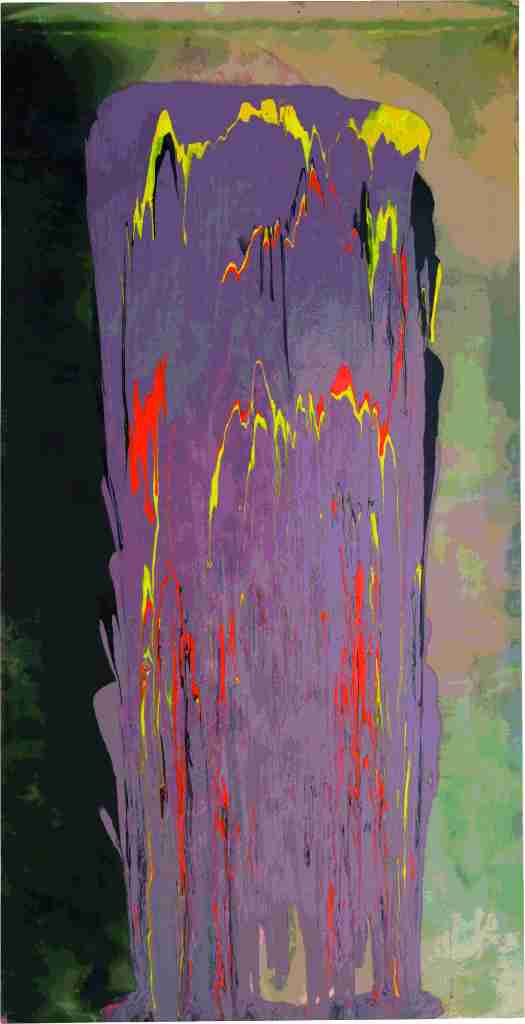
Grating Rhymes (1975), Frank Bowling. Courtesy the artist and Hales Gallery, London and New York; © the artist
Bowling’s persistent urge to reinvent painting has led him to experiment with elaborate procedures – stitching, staining, pouring, dripping, spilling. His richly coloured and thickly textured canvases, often featuring embedded objects, are the products of both predetermined ideas – ‘Everything is structured, I know what I’m doing,’ he says – and chance interventions. A recent display at the Arts Club in London, spanning 50 years of Bowling’s career, hinted at his range and the scale of his achievement. A much larger solo exhibition opens this month at Munich’s Haus der Kunst (23 June–7 January 2018), and his work will also feature in ‘Soul of a Nation: Art in the Age of Black Power’ at Tate Modern (12 July–22 October). Yet recognition has been slow to come. Although a pioneering figure – Bowling was the first living black artist to be collected by the Tate and the first black Royal Academician – he was not represented by a UK gallery until 2002 and his last major survey in Britain was at the Serpentine Gallery in 1986.
Born in 1936 in Bartica in British Guyana, Bowling did not come to painting immediately. ‘I didn’t know anything about museums and art because I was trying to write,’ he tells me, before alluding to the literary heritage of New Amsterdam, the town where he grew up. Bowling moved to London as a teenager in 1953 and did national service in the RAF, where he met Keith Critchlow, a talented draughtsman about to begin his studies at the Royal College of Art. Critchlow introduced Bowling to his art-school friends and took him to the National Gallery, where he was struck by the English landscape tradition. Over the following years, he says, ‘Painting got a grip on me and so I just painted all the time’; it became ‘more engaging and satisfying than writing’. Following a stint at the Chelsea School of Art, in 1959 Bowling was accepted on a scholarship to the RCA, where his contemporaries included David Hockney, R.B. Kitaj, and Patrick Caulfield. Was there a spirit of competitiveness? ‘Yes, I felt there was a hum,’ says Bowling, while also acknowledging his disadvantage at not having studied art at an earlier age; others had ‘the edge’. Driven to improve, he graduated in 1962, winning the silver medal to Hockney’s gold.
Bowling’s literary predilection, his desire to tell stories, was well matched with an English art-school tradition that revolved around representation: ‘I was burning with subject matter – that’s one of the reasons they [the RCA] took me on.’ Early figurative works took human suffering as their starting point, with expressionistic images of beggars and childbirth – forcefully depicted in his two Birthday works from 1960/61 – painted in dark, thick paint. They call to mind Rembrandt and Goya, major influences on Bowling at this time (Afternoon Nap from 1962, for example, borrows Goya’s violent figure of Saturn), but it is Francis Bacon who looms largest. Bowling felt challenged by Bacon’s friendship – they debated issues of space and perspective, he tells me – but the relationship deteriorated ‘when I got close and he tried to destroy me with his power […] He was a very articulate guy, violent and aggressive.’ In his Swan series (1964), hard-edge abstraction collides with elements from Pop and Op art, a stylistic disunity also clear in Cover Girl (1963–64), which shows Bowling in pursuit of a cooler aesthetic inspired by the prevailing trend towards Pop art. It was, Bowling admits, ‘a confusing time’.
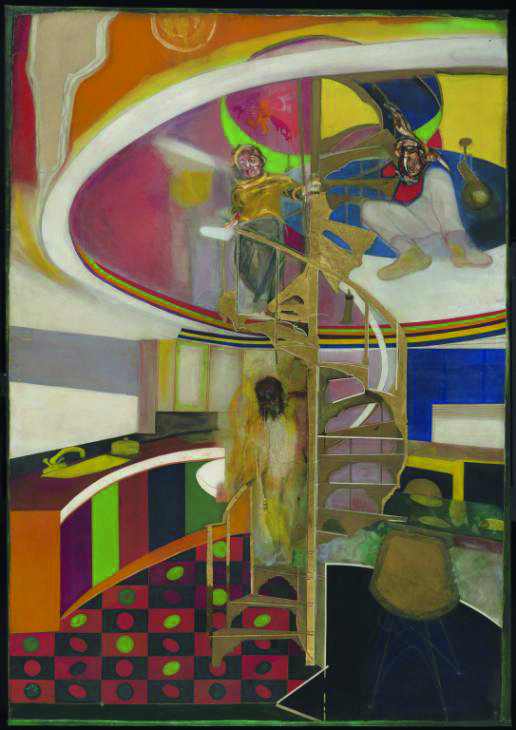
Mirror (1964–66), Frank Bowling. © the artist
Mirror (1964–66; currently on display in Tate Britain’s Walk Through British Art galleries) is a thrilling manifestation of this experimental moment. A combination of vying styles, the painting features a central staircase motif – modelled on the spiral stairs at the RCA – that suggests an artist in transition. Bowling dangles freely at the top right of the canvas, his face a Bacon-esque distortion; he also stands at the bottom, his outline hazy. In this dual depiction, the artist seems both suspended and isolated, neither here nor there. If there’s an anxiety, it’s more than purely stylistic. The third figure in the painting is Paddy Kitchen, whom Bowling married while at the RCA (for which he was temporarily expelled), and the work can be read as an attempt to unite art and life, by bringing recognisable architecture and figures to bear on his stylistic experiments with paint. During this period, Bowling also had to navigate the challenges that came with being an artist of Caribbean descent. Despite some initial success, his tendency towards social or political subjects – he took the assassination of the Congolese leader Patrice Lumumba as one starting point – perhaps hampered his critical reception during this period. Did he feel excluded? ‘I certainly did – like many Commonwealth artists.’
In 1962 Bowling had his first show at the Grabowski Gallery, and two years later he exhibited with the London Group at the Tate, but he was left out of other shows of British art – most notably the ‘New Generation: 1964’ exhibition held at the Whitechapel Gallery. At the time, curator Bryan Robertson proclaimed that ‘England is not ready for a gifted artist of colour.’ Bowling was pushed into representing Britain at the First World Festival of Negro Arts in Senegal, something he saw as ‘aggressive and personally insulting’. He talks of his desire to escape a certain postcolonial pressure, to avoid being pigeonholed. ‘I still insist that I’m not a black artist, I’m an artist. The tradition I imbibe and the cultural ramifications are British.’
His career stuttering, Bowling moved to New York in 1967, where his interest in abstraction took root. He would spend the next five decades shuttling back and forth across the Atlantic, and still has a studio under the Manhattan Bridge. He was encouraged to leave London by Larry Rivers – who said he was ‘stifling’ – as well as by modernist poets Frank O’Hara and John Ashbery, and he admits to feeling buoyed by a group of young black artists also pursuing abstraction against a charged American political backdrop. Bowling developed a strong critical voice as a contributing editor at Arts Magazine, and curated the seminal ‘5+1’ exhibition, in which his work was shown alongside that of five African-American abstract artists.
Bowling took issue with the Black Arts Movement, and rejected the notion of a ‘black art’ – ‘Yes I did, absolutely, because what I thought was being touted as black art was second-rate.’ He also resisted the tendency for black artists to be associated with primitivism; Bowling is a modernist and sees the black experience as inextricably tied to modernity. The intense debates around black art that took place in America in the ’60s are at the heart of Tate Modern’s ‘Soul of a Nation’, which will feature two of Bowling’s works. As the exhibition’s co-curator Zoe Whitley tells me, Bowling was ‘vocal about the critical invisibility of black artists stateside and pulled no punches regarding the narrow parameters by which his art and that of his peers was being assessed.’
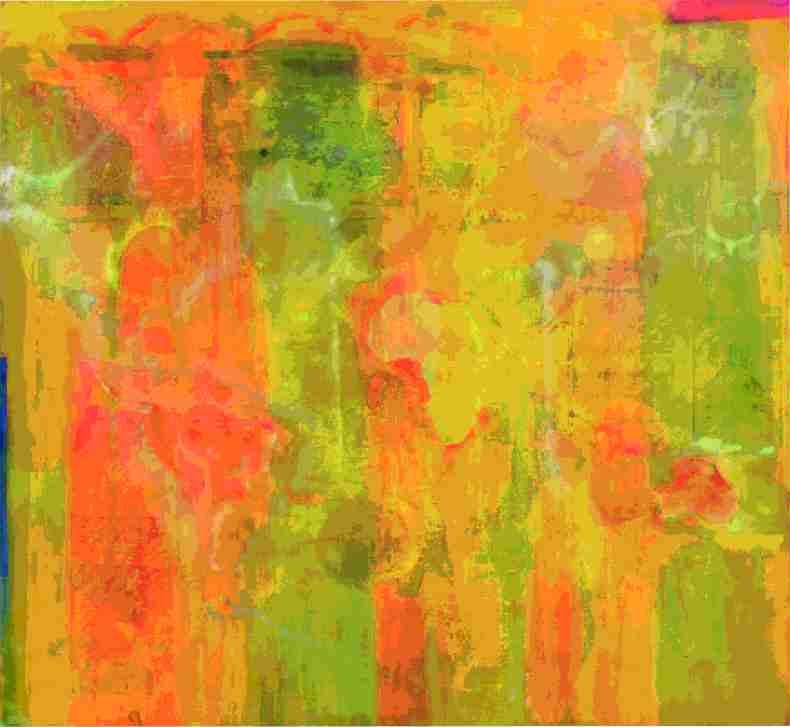
Where is Lucienne? (1971), Frank Bowling. Courtesy the artist and Hales Gallery, London and New York; © the artist
Bowling’s map paintings, made in New York, marked a transitional moment. He came across the motif ‘quite by accident’ while living in the Chelsea Hotel in the late ’60s. Laying a stained canvas on the floor, he followed the shadows cast by the window light with coloured paint – ‘a readymade geometric disposition’. As the paint settled it took on the appearance of a map of South America, reminding Bowling of drawing the map of Guyana freehand as a schoolchild. Subsequent maps, accurately stencilled using an epidiascope, suggest a concern with how personal identity can be shaped by displacement. In works such as Night Journey (1968–69) and Where is Lucienne? (1971), the ghostly outlines of South America and Africa are held in tension, hovering liminally on paint-streaked canvases. The map paintings also reveal an artist in a state of uncertainty. Bowling was hesitant as a black artist about pursuing a modernist formalism, fearing it was the preserve of a tradition that excluded him. He was encouraged by the critic Clement Greenberg, however: ‘Clem said “In America, there is no no-go area for anybody” – in defiance of the racism that was rampant. I took him at his word. I found my work was freed as my head was freed. Indeed, I think it would be true to say that he watched over my anxious moving through from figuration to abstraction.’ First shown at the Whitney in 1971 in a groundbreaking solo show, Bowling’s map works take centre stage in ‘Mappa Mundi’ at Haus der Kunst.

Cover Girl (1963–64), Frank Bowling. Courtesy the artist and Hales Gallery, London and New York; © the artist
Guyana has reappeared regularly throughout Bowling’s career, not least in his use of red, yellow and green paint – the colours of the Guyanese flag. Works as diverse as Cover Girl and Who’s Afraid of Barney Newman (both 1968), and his Crossings series (2011), in which the colours loosely drip and merge, all make use of the tricolour. Bowling is hostile to readings of his palette as exotic – ‘I had a lot of problems with that, I probably still have’ – or autobiographical, but as he admits, ‘I don’t think what you see or feel in the world when you open your eyes for the first time ever leaves you […] Historical memory is hardly ever erased.’ The recurring screen-printed image of his mother’s shop, Bowling’s Variety Store, and the layered landscapes from the 1980s that evoke Guyana’s marsh flats – such as the shimmering Barticaflats (1986) – suggest that Bowling’s canvases are repositories of personal memory and experience, and sites of loss.
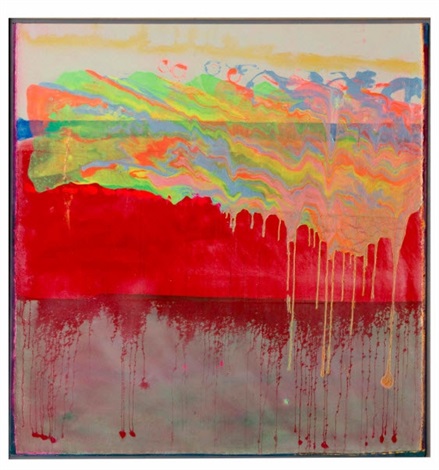
Ashton’smix (2014), Frank Bowling. Courtesy the artist and Hales Gallery, London and New York; © the artist
Bowling’s subject matter since the 1970s has been, as he affirms, ‘paint and colour, paint and colour’. The constraints of formalism initially allowed him a freedom to ‘criticise from the inside’ (borrowing from Greenberg’s belief in the self-critical nature of modernist painting). While Bowling’s early abstract works pay tribute to Rothko and Newman, in their titles as well as their atmospheric colour fields and frequent riffs on the zip motif, his more confident free-form poured paintings (the subject of a display at Tate Britain in 2012) mark a turn away from paint’s expressive qualities. A self-built tilting platform enabled him to pour paint directly on to an angled canvas, the paint spilling and gathering at the bottom, a method indebted to the ‘post-painterly’ procedures prevalent in New York. He tells me that he has ‘never stopped pouring […] One gets a process and tries to push it.’ Ashton’smix (2014), for example, resembles his earlier poured works but here the paint weaves across rather than down the canvas. Bowling is still occupied with new ways to apply paint – ‘with brushes, poured, spilt, dripped’ – and while he continues to work on the wall and the floor, the table has become central. ‘But it still moves around, nothing stops still.’ And the element of surprise as he paints, he says, ‘holds sway over my physicality. I feel good working.’ How does he know when a painting is finished? ‘I’m very involved in the thingness of the thing. It must have the right feel in terms of its shape and weight.’
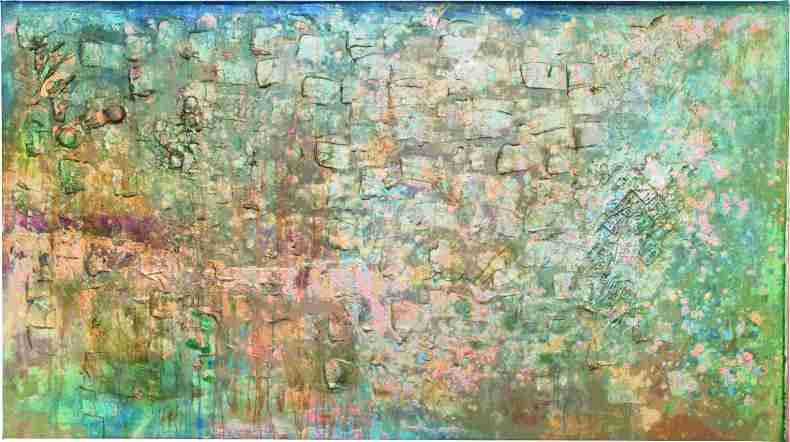
Frank Bowling, Great Thames II, 1989, acrylic on canvas, 181 x 323.5 cm Courtesy the artist and Hales Gallery, London and New York; © the artist
The complex surfaces in Bowling’s later works, especially from the 1980s and ’90s, are the result of elaborate processes and techniques. Spreadout Ron Kitaj (1984–86) heaves under the weight of its materials, its depth and shine exaggerated by Bowling’s use of metallic pigments, fluorescent chalk and acrylic gels. The latter, along with Styrofoam, are common components in works from this period, and give his paintings a raised, tactile quality. His iridescent Great Thames paintings (1989), made in a studio in Cable Street with a just-visible view of the Thames, beautifully capture the play of London light on water and hint at his debt to the English painters he has spent a lifetime admiring. ‘The English landscape tradition is a rich vein that I could keep ploughing,’ he muses, ‘but I don’t want to make Constables, I want to make new works that have a spirit and richness.’
Bowling’s titles are allusive and poetic, lifting the works into a world beyond themselves and creating a tension with their formal qualities. Some conjure the idea of a place (Chaguaramus Bay; 1989), or recollect personal moments (SachaJasonGuyanaDreams; 1989), while others are just plain whimsical (Squashed Unicorn; 1983). Bowling has previously spoken of how his titles function like a diary, memory triggers that help him fight against forgetting. They remind me of the embedded objects in his paintings, bits of his life caught and held forever: dipsticks used to test for diabetes, letters (Girls in the City; 1991), plastic toy insects (Horsing Around; 2016), and needles (which allude to his mother, a seamstress). How does he account for the literary quality of his titles? ‘Having dwelt on it painfully, I concluded that there’s a sense in which my titling is a pathologising for the loss of not being a poet. I’m also conscious of the way the Irish use language. It’s very deep in me, I think – the part of Guyana I grew up in was very Irish.’
I meet Bowling a few weeks later at his studio across the Thames in Southwark. He tells me that he visits every day, sometimes twice. What keeps him painting? ‘Anxiety, I want to get better.’ The compact space is crammed full of canvases, the fluorescent edges of densely worked paintings just visible. Their dates and enigmatic titles are tacked along the sides: Upwards (1977), For You and Me (1988), Abary (2009). A paint-splattered apron hangs on a ladder, beside a table crowded with paint pots, pens jammed in jars, and, more curiously, a bag of plastic insects and some pearl barley. At one point, Bowling uses a bottle to squirt water at a rough canvas hanging on the opposite wall, while Scott, who assists him in the studio – ‘I do what I’m told,’ she jokes – manoeuvres a portable heater below the painting. Across the yard is another room brimming with Bowling’s paintings, soon to be moved into permanent storage (he admits he’ll be sad to see them go). Scott tells me that almost every week Bowling produces a new work, usually on a large scale. ‘He often can’t sleep, he’s always thinking about what he’s going to be doing the next day. His life has always been about painting, coming over here.’
The pearl barley, it turns out, is one ingredient in a new work, the little beads clinging to the surface of the canvas. I see now what Bowling meant when, at our first meeting, he said that he’d been ‘risking some things with the old procedures […] constantly trying to push it over the edge [and] looking for what will surprise me in the work’. On sitting his RCA entrance exam in the late 1950s, Bowling was asked whether painting’s grip on him would die down in favour of writing. ‘I had to prove that wasn’t going to be the case,’ he tells me, ‘and it hasn’t been.’
‘Frank Bowling: Mappa Mundi’ is at Haus der Kunst, Munich, from 27 June–7 January 2017.
From the June issue of Apollo. Preview and subscribe here.
Unlimited access from just $16 every 3 months
Subscribe to get unlimited and exclusive access to the top art stories, interviews and exhibition reviews.

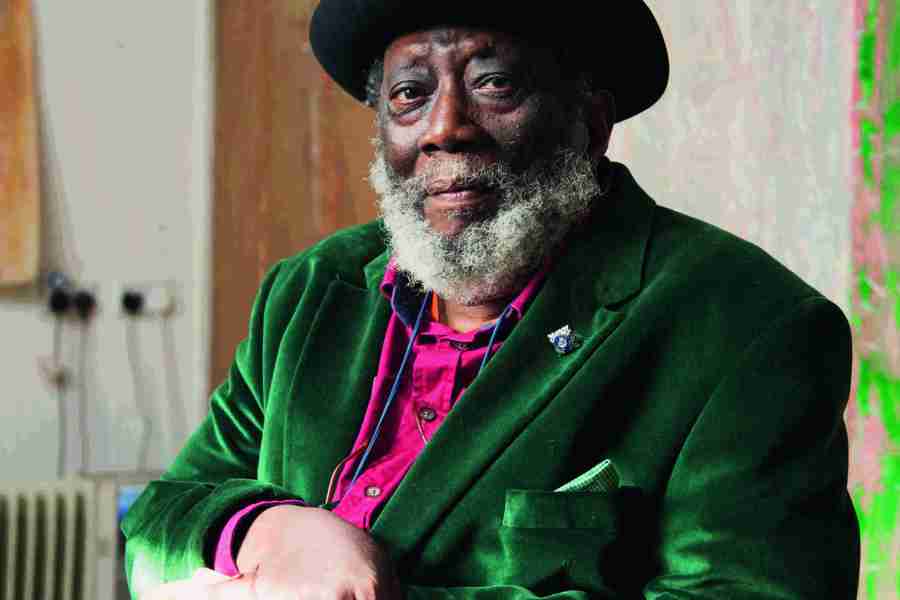
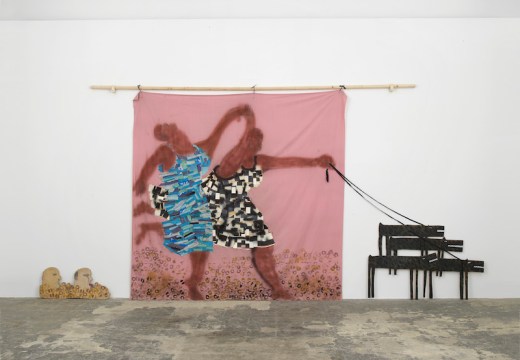











![Masterpiece [Re]discovery 2022. Photo: Ben Fisher Photography, courtesy of Masterpiece London](http://www.apollo-magazine.com/wp-content/uploads/2022/07/MPL2022_4263.jpg)
Why are fathers so absent from art history?